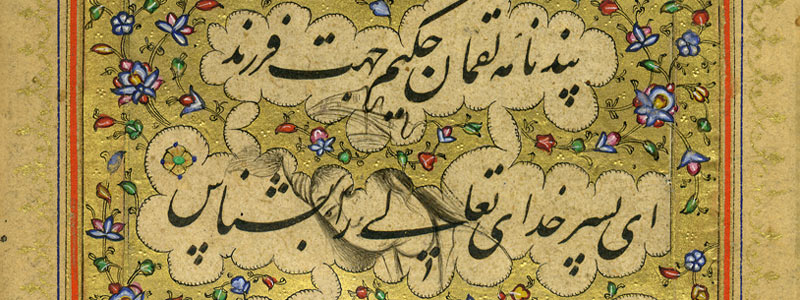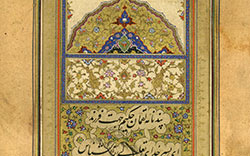Mir ‘Emād was born in 1554 CE. His father was one of the sayyeds of the Sayfi clan in Qazvin. After completing his primary education, he traveled to study with Mohammad Hosayn Tabrizi, with whom he learned the intricacies of the Nasta‘liq script and studied important works of early and contemporary calligraphers. Mir ‘Emād began his career in the service of Farhād Khān Qarāmānlu, a military commander of Shāh ‘Abbās (1588-1629 CE). Following the execution of Farhād Khān in 1598 CE, he secluded himself for a while before setting out for Isfahan in order to work and propagate his own school of calligraphy and art.
Though the rules of the Nasta‘liq script were formulated and standardized by Mir ‘Ali Tabrizi (1401 CE), in Mir ‘Emād’s works the script reached the height of its perfection. Through his ingenuity, many of the imperfections in the letters, words, and guidelines of the script were eliminated. During his residence in Isfahan, Mir ‘Emād trained many pupils, including Nur-al-Din Mohammad Lahiji, ‘Abd-al-Jabbār Esfahāni, Abu-Torāb Esfahāni, Mohammad Sāleh Khātun Ābādi, ‘Abd-al-Rashid, and his own daughter, Goharshād.
Mir ‘Emād's school also found favor with many aficionados outside of Iran, especially in the courts of India and the Ottoman Empire, to the point that his calligraphy came to be widely regarded as the greatest example of the Nasta‘liq script. Ottoman artists, such as Vali-al-Din Efendi, Mohammad As‘ad al-Yasāri, and Sayyed Mohammad Dadah-Zādeh could be counted among Mir ‘Emād’s distant pupils and worked to further his school. There are also some extant poems by Mir ‘Emād that point to his kind nature and modest taste.
As a result of his widespread fame, even in his own time, some profiteers forged works in his name. Although there are many Mir ‘Emād forgeries, art connoisseurs can still distinguish his works because they are clearly marked by his exquisite ability and knowledge.
There are no genuine, extant works of Mir ‘Emād other than a few outstanding pieces and rare books such as Sa‘di's Golestān and Bostān and Khawja ‘Abd-Allāh Ansāri's Monājāt-nāma. A few of his works can be found in Turkish and Russian museums. These were used in preparation for this site.
As a result of unfounded accusations that he was a Sunni, Mir ‘Emād met his end dishonorably at hand of one of the Shi’i king, Shāh ‘Abbās's, attendants in 1615 CE. He was buried in the Maqsud Bayk Mosque near the Naqsh-e Jahān Square in Isfahan.





